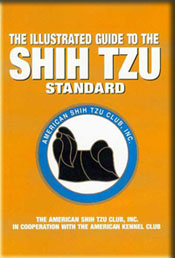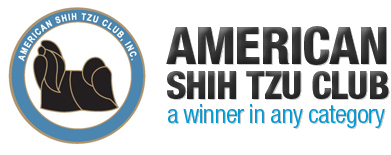The Illustrated Guide To The Shih Tzu Standard | Standard
 CONTENTS: Front Cover | Preface | History | Anatomy | STANDARD | General Appearance | Size, Substance | Proportion | Head | Neck, Body | Topline | Tail | Forequarters | Hindquarters | Coat, Trimming, Color, and Markings | Gait
CONTENTS: Front Cover | Preface | History | Anatomy | STANDARD | General Appearance | Size, Substance | Proportion | Head | Neck, Body | Topline | Tail | Forequarters | Hindquarters | Coat, Trimming, Color, and Markings | Gait


The Shih Tzu is a sturdy, lively, alert toy dog with long flowing double coat. Befitting his noble Chinese ancestry as a highly valued, prized companion and palace pet, the Shih Tzu is proud of bearing, has a distinctively arrogant carriage with head well up and tail curved over the back. Although there has always been considerable size variation, the Shih Tzu must be compact, solid, carrying good weight and substance. Even though a toy dog, the Shih Tzu must be subject to the same requirements of soundness and structure prescribed for all breeds, and any deviation from the ideal described in the standard should be penalized to the extent of the deviation. Structural faults common to all breeds are as undesirable in the Shih Tzu as in any other breed, regardless of whether or not such faults are specifically mentioned in the standard.
SIZE, PROPORTION, SUBSTANCE
SIZE — Ideally, height at withers is 9 to 101/2 inches; but, not less than 8 inches nor more than 11 inches. Ideally, weight of mature dogs, 9 to 16 pounds.
PROPORTION — Length between withers and root of tail is slightly longer than height at withers. The Shih Tzu must never be so high stationed as to appear leggy, nor so low stationed as to appear dumpy or squatty.
SUBSTANCE — Regardless of size, the Shih Tzu is always compact, solid and carries good weight and substance.
HEAD
HEAD — Round, broad, wide between eyes, its size in balance with the overall size of dog being neither too large nor too small. [Fault: Narrow head, close-set eyes.]
EXPRESSION — Warm, sweet, wide-eyed, friendly and trusting. An overall well-balanced and pleasant expression supersedes the importance of individual parts. Care should be taken to look and examine well beyond the hair to determine if what is seen is the actual head and expression rather than an image created by grooming technique.
EYES — Large, round, not prominent, placed well apart, looking straight ahead. Very dark. Lighter on liver pigmented dogs and blue pigmented dogs. [Fault: Small, close-set or light eyes; excessive eye white.]
EARS — Large, set slightly below crown of skull; heavily coated.
SKULL — Domed.
STOP — There is a definite stop.
MUZZLE — Square, short, unwrinkled, with good cushioning, set no lower than bottom eye rim; never downturned. Ideally, no longer than 1 inch from tip of nose to stop, although length may vary slightly in relation to overall size of dog. Front of muzzle should be flat; lower lip and chin not protruding and definitely never receding. [Fault: Snipiness, lack of definite stop.]
NOSE — Nostrils are broad, wide, and open.
PIGMENTATION — Nose, lips, eye rims are black on all colors, except liver on liver pigmented dogs and blue on blue pigmented dogs. [Fault: Pink on nose, lips, or eye rims.]
BITE — Undershot. Jaw is broad and wide. A missing tooth or slightly misaligned teeth should not be too severely penalized. Teeth and tongue should not show when mouth is closed. [Fault: Overshot bite.]
NECK, TOPLINE, BODY Of utmost importance is an overall well-balanced dog with no exaggerated features.
NECK — Well set-on flowing smoothly into shoulders; of sufficient length to permit natural high head carriage and in balance with height and length of dog.
TOPLINE — Level.
BODY — Short-coupled and sturdy with no waist or tuck-up. The Shih Tzu is slightly longer than tall. [Fault: Legginess.]
CHEST — Broad and deep with good spring-of-rib, however, not barrel-chested. Depth of ribcage should extend to just below elbow. Distance from elbow to withers is a little greater than from elbow to ground.
CROUP — Flat.
TAIL — Set on high, heavily plumed, carried in curve well over back. Too loose, too tight, too flat, or too low set a tail is undesirable and should be penalized to extent of deviation.
FOREQUARTERS
SHOULDERS — Well angulated, well laid-back, well laid-in, fitting smoothly into body.
LEGS — Straight, well-boned, muscular, set well-apart and under chest, with elbows set close to body.
PASTERNS — Strong, perpendicular.
DEWCLAWS — May be removed.
FEET — Firm, well-padded, point straight ahead.
HINDQUARTERS Angulation of hindquarters should be in balance with forequarters.
LEGS — Well-boned, muscular, and straight when viewed from rear with well-bent stifles, not close set but in line with forequarters.
HOCKS — Well let down, perpendicular. [Fault: Hyperextension of hocks.]
DEWCLAWS — May be removed. Feet-Firm, well-padded, point straight ahead.
COAT
COAT — Luxurious, double-coated, dense, long, and flowing. Slight wave permissible. Hair on top of head is tied up. [Fault: Sparse coat, single coat, curly coat.]
TRIMMING — Feet, bottom of coat, and anus may be done for neatness and to facilitate movement. [Fault: Excessive trimming.]
COLOR AND MARKINGS All are permissible and to be considered equally.
GAIT The Shih Tzu moves straight and must be shown at its own natural speed, neither raced nor strung-up, to evaluate its smooth, flowing, effortless movement with good front reach and equally strong rear drive, level topline, naturally high head carriage, and tail carried in gentle curve over back.
TEMPERAMENT As the sole purpose of the Shih Tzu is that of a companion and house pet, it is essential that its temperament be outgoing, happy, affectionate, friendly and trusting towards all.
